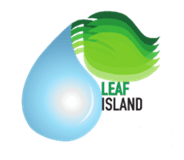
About Leaf Island
Improving environmental quality in the increasingly dense human populations of cities stands among the most pressing concerns of our time. The UN estimates that 68 percent of the world’s population will live in urban areas by 2050; 82 percent of the US already does[1]. Leaf Island provides a scalable and replicable system of related products that integrate essential ecological layers to the existing built environment. Our products effectively and affordably cool cities, improve water management and clean the atmosphere, offering help and health for current and future urban areas to thrive in the face of increasing climate challenges. In short, Leaf IslandTM technologies collectively work to transform the currently lifeless surfaces of the built environment: rooftops, walls, streets and coastlines into living, ecologically functioning spaces that increase both the social and ecological productivity of urban areas.
If you add the same surface area of leafy green plant structures and put them in appropriately designed layers on enough of the flat roofs, walls, streets and other surfaces of a city to match the amount of natural leaf cover that existed prior to that city’s being built, you can reproduce the same temperatures that existed prior to that city’s construction. You can do this without massive retrofits or removal of the built environment.
– The Leaf Island Effect
Cities around the world suffer from urban heat islands, rising sea level, combined sewage overflows, air pollution, and waste management costs and inefficiencies. Thermal loads in the atmosphere and oceans as well as the frequency of powerful storms and sea level rise are increasing ever more rapidly. Our built environment and supporting infrastructure were not designed to replicate the resilient capacities of archipelagos, marsh grass meadows, reefs and the forests that preceded them. As one example, arrays of island reefs drop the power of storm-driven waves and current ten-fold by tessellating high and low energy habitat, while incorporating ecological productivity in coastal protection. The power of these natural arrays to absorb and respond to storm surges are far beyond the capacities of featureless concrete bulkheads.
Leaf Island is focused on the design, testing, and fabrication of modular, scalable and easily replicable green/blue infrastructure products and technologies that replicate resilient processes found in nature. Beyond evolving infrastructure itself, Leaf Island’s methodology is structured around the efficient interface of waste streams, manufacturing, distribution and installation networks. In combination, Leaf Island’s award-winning products return ecosystem functions to cityscapes, roads and rooftops by scaling ecology on otherwise all too sterile surfaces to protect and aesthetically enrich inhabitants of cities by promoting local and regional biodiversity.
Nature develops self-organizing assemblies, even if constrained to work on dry sand dunes or in wet clay pockets. Through the invisible work of roots and microbes, select light rays capture carbon and more, with solar energy coupling the stream of minerals from roots with the carbon dioxide dissolving in the water film within the leaves. At the same time this very process lowers local temperature into a range far more amenable to butterflies, beetles, birds, and many of the rest of us. Biomass and biological activity in the rhizosphere developed around this work, which can even sequester metals and break down hazardous hydrocarbons in the process. Every dead ant or bee, twig or curled leaf becomes layered with bacteria or becomes so penetrated by fungal strands that only minerals and humus remain, themselves the reservoirs that power new growth.
Leaf Island technologies collectively work in the same way, transforming the lifeless surfaces of the built environment. Enormous volumes of these inert surfaces already surround us; interfaces constructed to shelter and move us, along with the flow of materials and energy at work in our cities. Leaf Island is focused on ways to retrofit these surfaces with the transformative powers intrinsic to layers of leaves and reservoirs of soil and water partly reclaimed from the urban waste stream itself. In short our business is organised to facilitate an evolutionary retrofit of the interfaces of existing structure and infrastructure, from industrial sites to private assets.
Technologies of the wastes-into-resources landscapes we have built and aim to further here are grounded in a logistic coupling of urban metabolism with the powers of ecological productivity and carbon capture. Leaf Island technologies incorporate recycled glass, plastics, brick and concrete aggregates and Styrofoam among other integral elements of our waste stream. The essence of this process is simple: Identify flows of material through the City, then discover and adapt methods that can allow these to serve as raw material for regenerative product manufacturing and ecological development. Our commitment to waste reduction ensures that adaptive reuse of elements output from the city’s waste stream are repurposed to improve the multi-functionality of existing assets and to reintroduce and reposition ecological productivity in the urban ecosystem.
Cities can only continue to provide economic, social, and creative functions and improve residents’ quality of life by folding into their fabric Dylan Thomas’ “The green fuse” itself, those living leaves and shoots which delight us, even as they work to clean air and water. Cities already furnish us with an immense, near-empty palette of multiple man-made surfaces which we here take as an invitation to ‘build with nature’ upon multiple man-made surfaces. Our methods and technology allow environmental benefits of increased vegetation, regenerated wetlands, porous landscapes, and constructed aquifers to be scaled to the problems and flows of the city. Resulting environmental benefits are comparable to, and may even exceed those found in more natural settings.
Layering the built environment with natural systems opens pathways to increased energy efficiencies, restored natural coastlines and enhanced biodiversity of landscapes and waterways, powering the new green/blue wastes-into-resources economy in the process.
Grey water alone in New York City, spread over the 300 mi2 landscape, is about equal to total annual rainfall. Evaporating this much water in the City provides more cooling energy than the peak electric load. Such physical facts point to intrinsic opportunities.

